One of the remaining unbeaten teams in the league, Manchester United, welcomed Crystal Palace in the third match week of the Premier League. They had secured three points on the opening day of the season with a dominant 4-0 win against Chelsea and saved a point when they played Wolves. Meanwhile, Roy Hodgson’s side hadn’t had the best start to the campaign. Picking up only one point against Everton, they were still looking for their first win.
Being the underdog in this matchup, the away side went for a negative state as they defended deep inside their half. But Jordan Ayew’s goal in the 32nd minute gave them an advantage as the first half came to a close. When the game reached the last minutes, Daniel James equalised for Man United. The game’s twist came inside stoppage time when Patrick van Aanholt scored the winning goal for Palace.
This tactical analysis will provide an analysis of the match between Man United vs Crystal Palace. Meanwhile, using statistics, we will point out what went wrong with Man United’s tactics against Crystal Palace’s tactics.
Lineups
The home side lined up in a 4-2-3-1 formation. Alexis Sánchez remained doubtful as he lacked match fitness to join up with the squad. Furthermore, they also didn’t have the service of three defenders Eric Bailly, Diogo Dalot and Timothy Fosu-Mensah due to different reasons. Nemanja Matić and Juan Mata appeared on the bench with youngsters Mason Greenwood and Axel Tuanzebe ready to make an appearance.
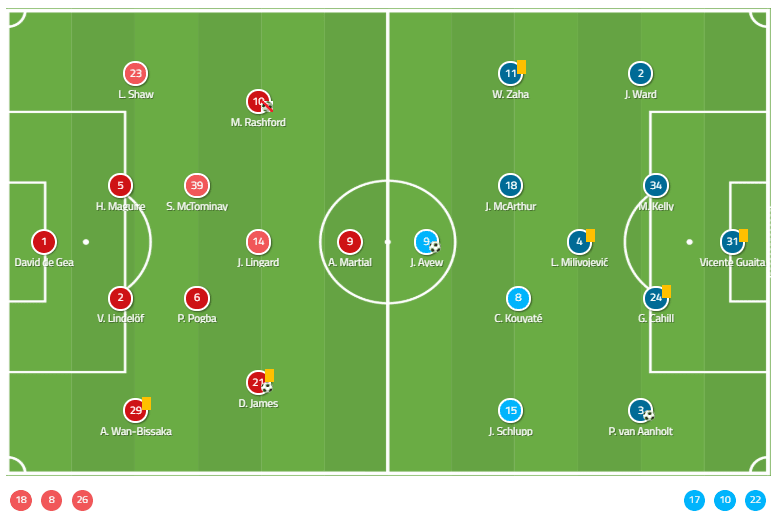
Hodgson also didn’t have the service of his key defenders Mamadou Sakho (knee injury) and James Tomkins (calf injury). Besides these two players, Crystal Palace had a full-strength starting lineup to play in this match. New signing Víctor Camarasa also waiting for his debut for the club but he didn’t make the bench list.
Man United’s style of play
At the beginning of the match, it’s easy to tell that the home side intended to focus on building their attacks from the back. Two centre-backs formed a passing block with two central midfielders up front. They positioned themselves in the central area of the pitch to have the best perspective on the game.
With four players among that block all comfortable on the ball, they were able to recycle possession against Crystal Palace’s pressure. Meanwhile, both wing-backs located inside the opposition half and were ready for the attack. They could also drop deep and involved in the build-up by offering a passing option out wide.
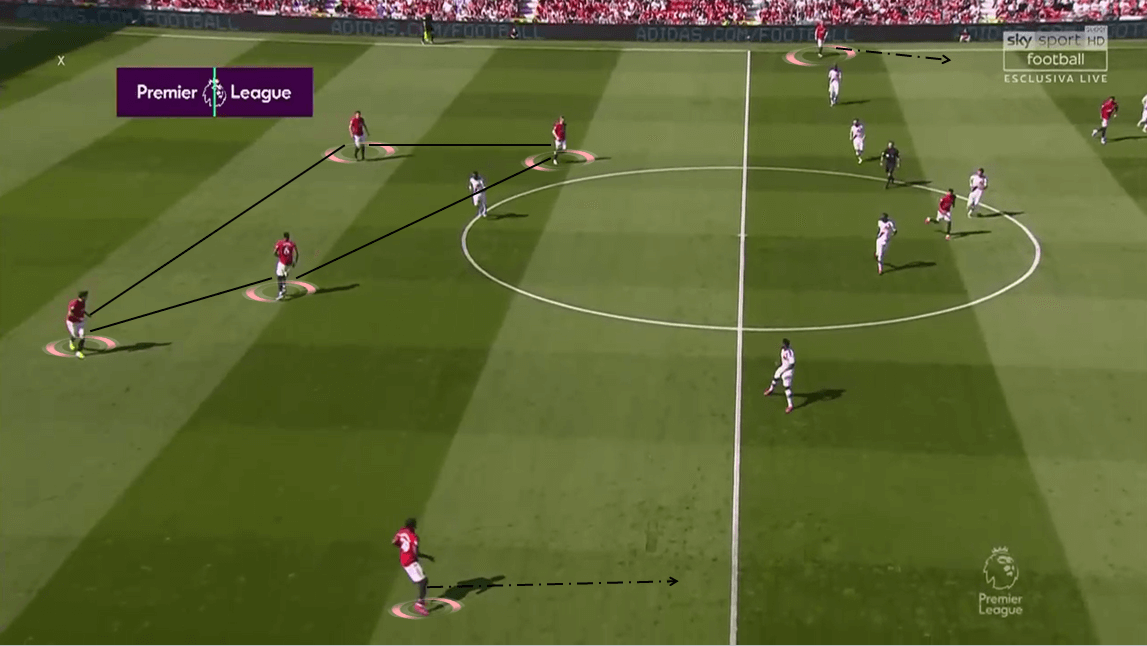
The full-back’s positioning was also crucial when they attempted to get the ball into the opposition’s half. From the centre-back’s position, either Harry Maguire or Victor Lindelöf would make a long ball towards the full-back and created an overlapping chance for him.
But since Palace were too quick in creating overloads on both flanks, Aaron Wan-Bissaka and Luke Shaw didn’t have many chances to show themselves. They could have dribbled with the ball and entered the area near the 16-yard box. Then, a whipped cross would be made into it towards the runs of Anthony Martial and Marcus Rashford. Sojskjær intended to threaten Crystal Palace’s box using that plan but it was crossed out in the first minutes of the game.
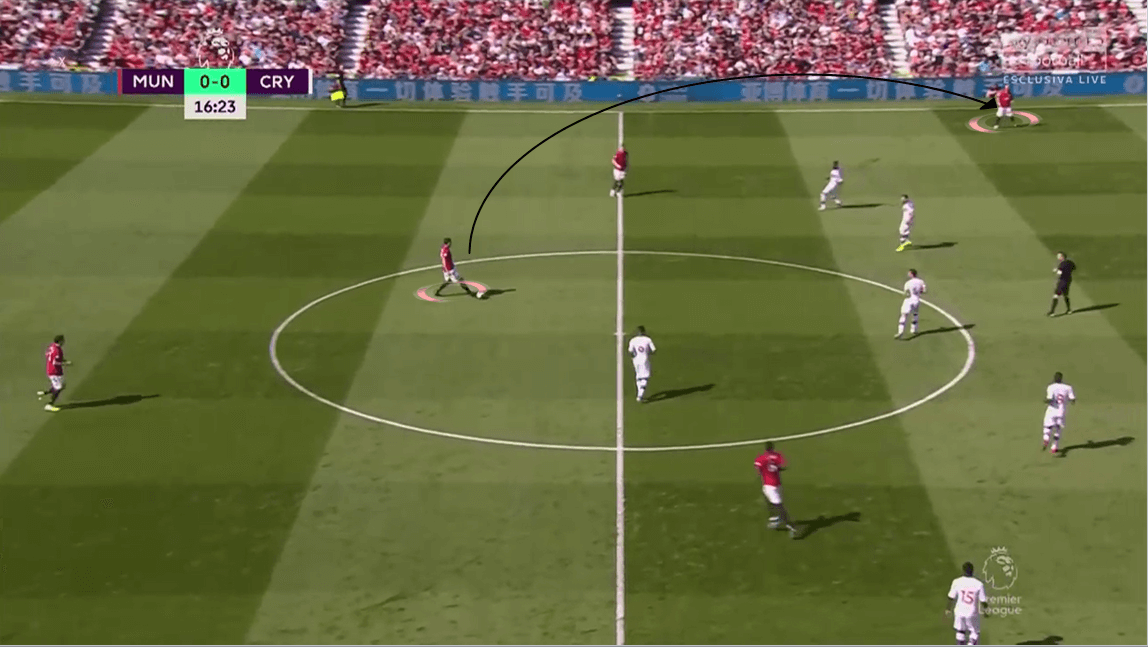
Inside the second half, though, they revisited the plan with some small changes to it. The Norwegian manager encouraged his players to switch positions with each other as they moved the ball into the box. The full-back usually attacked from deep and capitalised on spaces while turning himself as an available passing option for the ball carrier.
Meanwhile, Rashford dribbled the ball wide from his position and it would be occupied by Martial. He also attracted the defenders’ attention at the same time, leaving the space behind their back vulnerable. To keep the ball carrier away from being suffocated, one of the wingers would move close to him and offer to pick the ball up. He stuck to the wide-area and picked out the best option to execute the next move in case the ball carrier passed the ball to him.
Furthermore, even the central midfielders could join the situation by locating in a space to get the ball out of the overloaded area. Although it might interrupt their attack, it gave them a chance to restart it and looked for a more viable way to approach the goal.
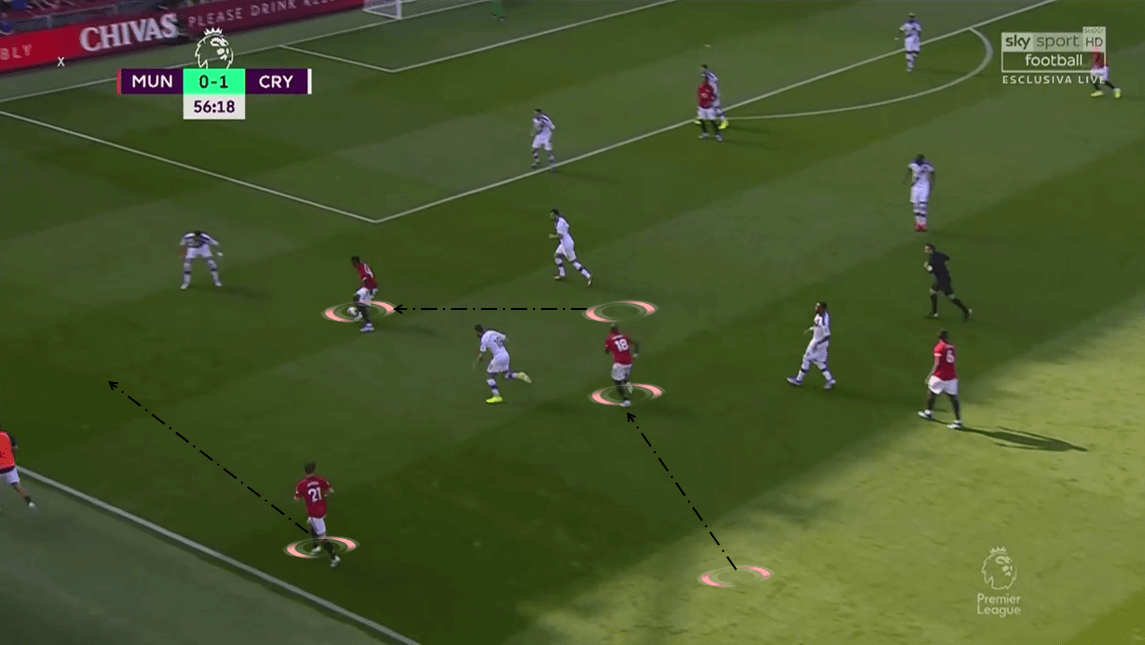
As we mentioned about how the home side built their attacks on the wing, it’s also worth noticing about Daniel James’ role. Starting as a right-winger, the Welsh winger usually stuck to the wide-area to stretch Crystal Palace’s defensive structure. It would create spaces for his teammates to move in and pick up the through ball.
But as the game passed the 55th-minute mark, James was moved to the left-hand side while substitute Mason Greenwood filled in his spot. Playing on the opposite side with his favoured foot, James was expected to work inside the right half-space and support the players in central. He could also cut inside when he had the ball at his feet and create chances for himself.
You would expect that James would create more threat from the position that fitted his preferred foot, but the opposite happened. Five out of his six dribble attempts came from the left area, while surprisingly, he made five crosses into the box from the same space. His equalising goal also came from his movement in the left space into the central area to pick up the ball from Martial.
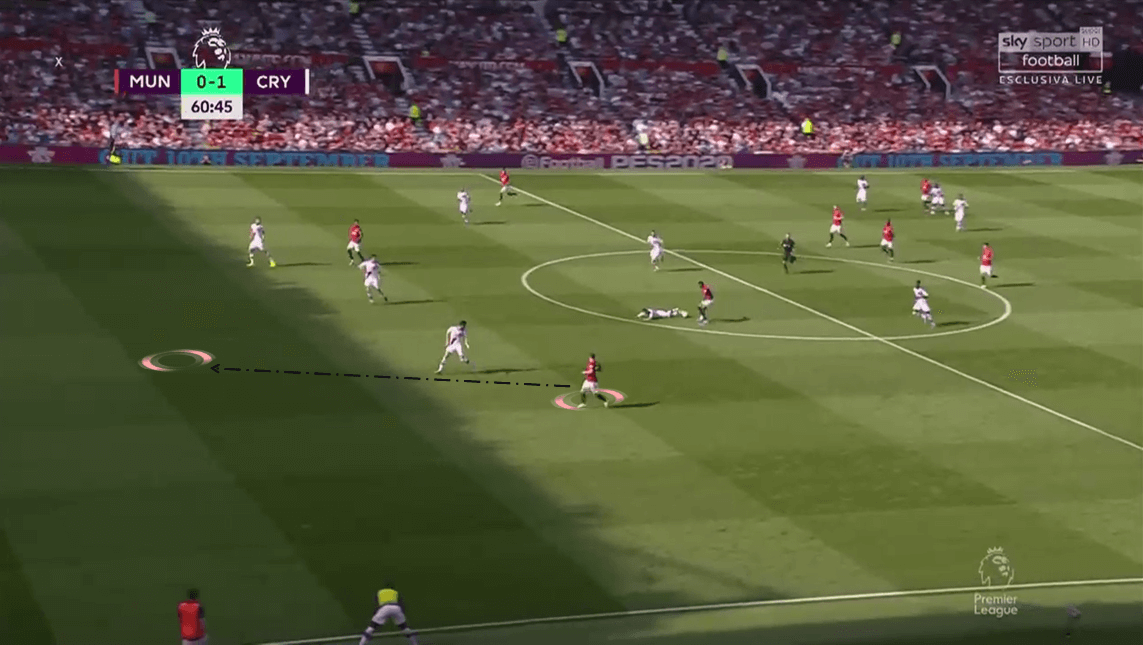
Man United entered the match with a more conservative state but were still able to play high tempo football. Without the ball, they defended with a clear 4-2-3-1 formation. Rashford usually stayed high and closed down the ball-carrier as he attempted to win the ball back.
Below him, three attacking midfielders formed the second line of their structure and their responsibility was to support Rashford in marking Crystal Palace’s defence. They would close down possible passing options, surround the ball-carrier and tackle the ball if it came towards them.
The defenders and two central midfielders stayed compact in front of their box and formed the last line of defence. Pogba and McTominay tried to limit spaces in between and prevented Crystal Palace’s attacking midfielders from working inside of it. Meanwhile, four defenders screened the box and alerted to any possible passes to drag the whole structure down.
High up the pitch, the four attacking players adapted a very aggressive press that heavily relied on pace and positioning. When Hodgson’s side built from the back, Rashford would position inside the build-up shape to intercept passes in between the players. Also, they could capitalise on heavy touches and recover possession for a dangerous chance.
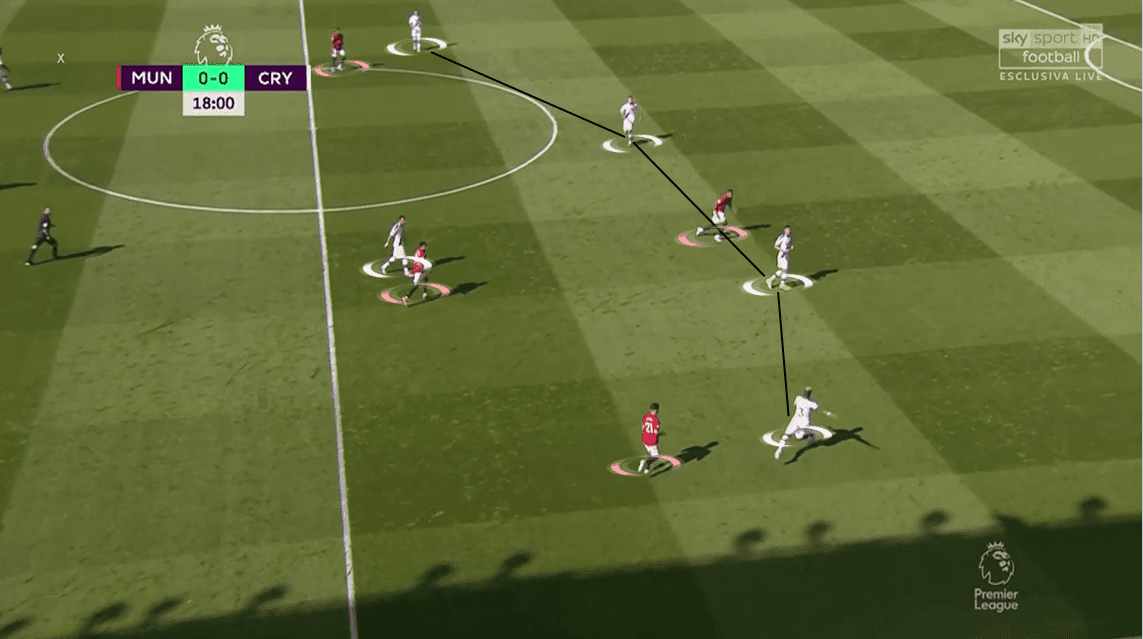
Crystal Palace’s style of play
Hodgson adopted a very conservative approach in both defence and pressing their opponent. During Man United’s build-up, they pushed their midfield five up the pitch while Jordan Ayew moved laterally and attempted to recover possession from the centre-backs.
Meanwhile, five midfielders pushed into the opposition’s half and created a shield on the edge of the halfway line. The central midfielders stuck to their position to screen the half and the wingers had the option of pushing up to support Ayew. But they didn’t adopt an aggressive attitude when they won the ball as conceding unnecessary fouls wasn’t their aim.
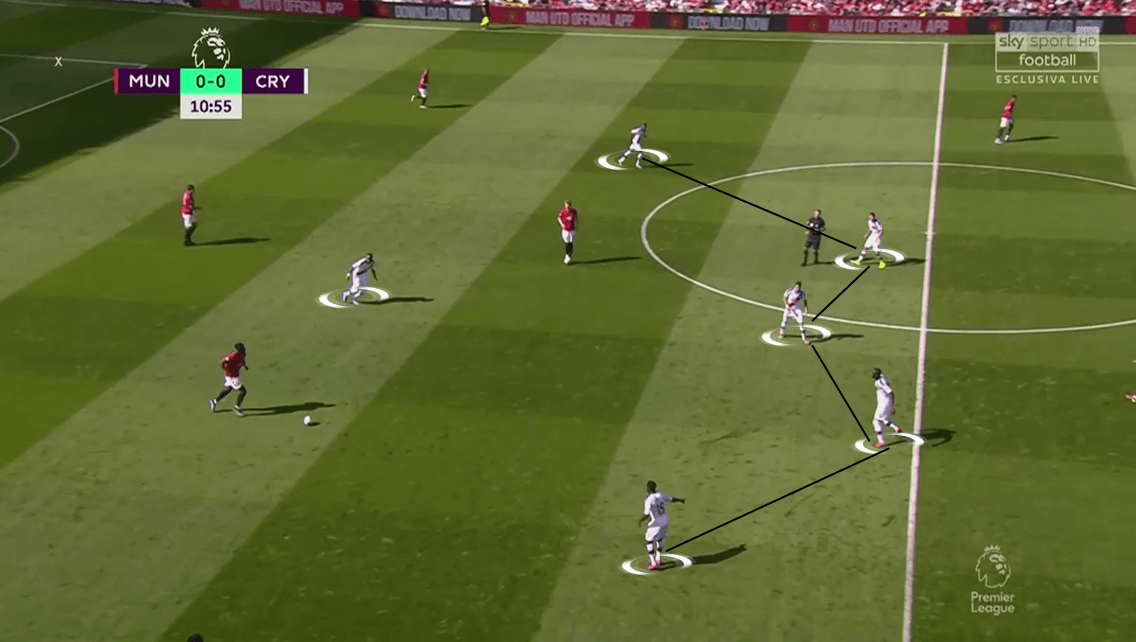
While the press occurred, the defenders pushed their line higher up the pitch rather than staying deep inside their half. They stretched wide and filled in both the central area and the half-spaces. This narrowed the spaces that Man United attackers could have to create combinations in between each other and approach the box easier.
Furthermore, either Luka Milivojević or Cheikhou Kouyaté could drop deep and screen the defence. He acted as a defensive midfielder and was responsible for intercepting passes or through balls. During the team’s build-up, his role was crucial as he could form passing triangles with the defenders to bypass the pressure from the opposition.
If the ball was moved into their defensive third, their 4-5-1 defensive structure would swarm that area and prevented short combinations between the players. They aimed to force the home side to distribute the ball wide and limited the spaces in between the lines. With five players forming the line, one midfielder could move into the flank while still holding the shape. Also, he became the focal point for their structure to shift laterally across the pitch to execute their plan.
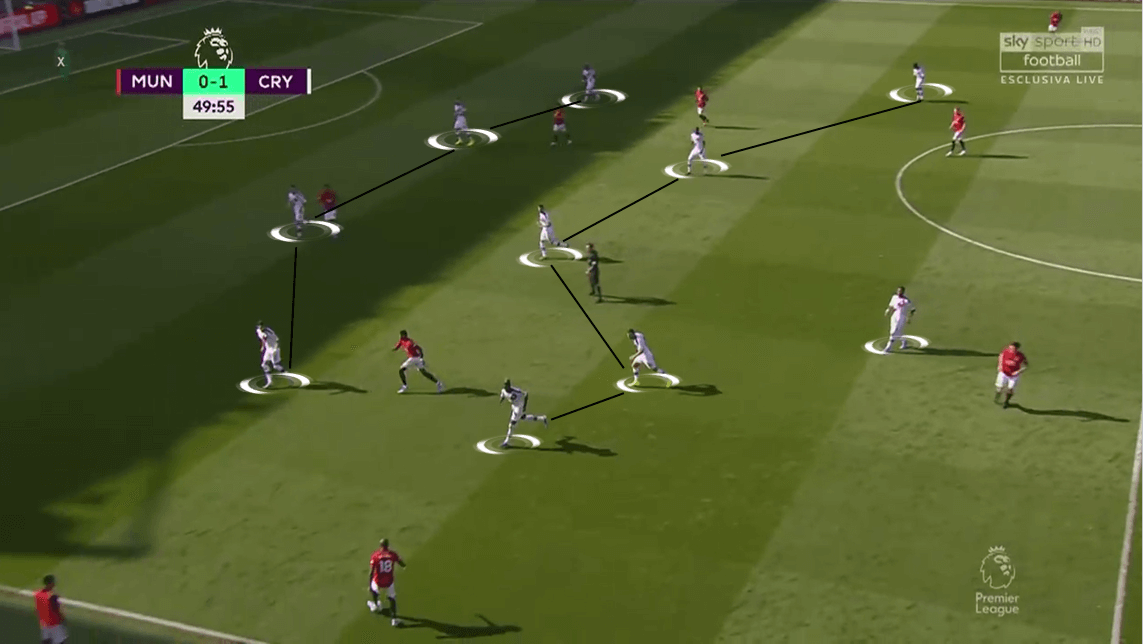
And that plan was to create overloads inside the wide area. With the numerical superiority that they had when defending deep, the players were able to stick to their positions and formed a cage around the ball carrier. It would prevent the ball carrier from progressing into their box and had to make a backpass to restart the attack.
But this also left a problem which Man United occasionally capitalised. When they attempted to overload the wing, one centre-back and one central midfielder had to move across into the half-space. If his teammate couldn’t cover that space up, they could leave a big gap centrally which Rashford or Martial would move in. Then, a lofted ball towards them created a dangerous chance in which most Palace defenders weren’t able to recover from their positions.
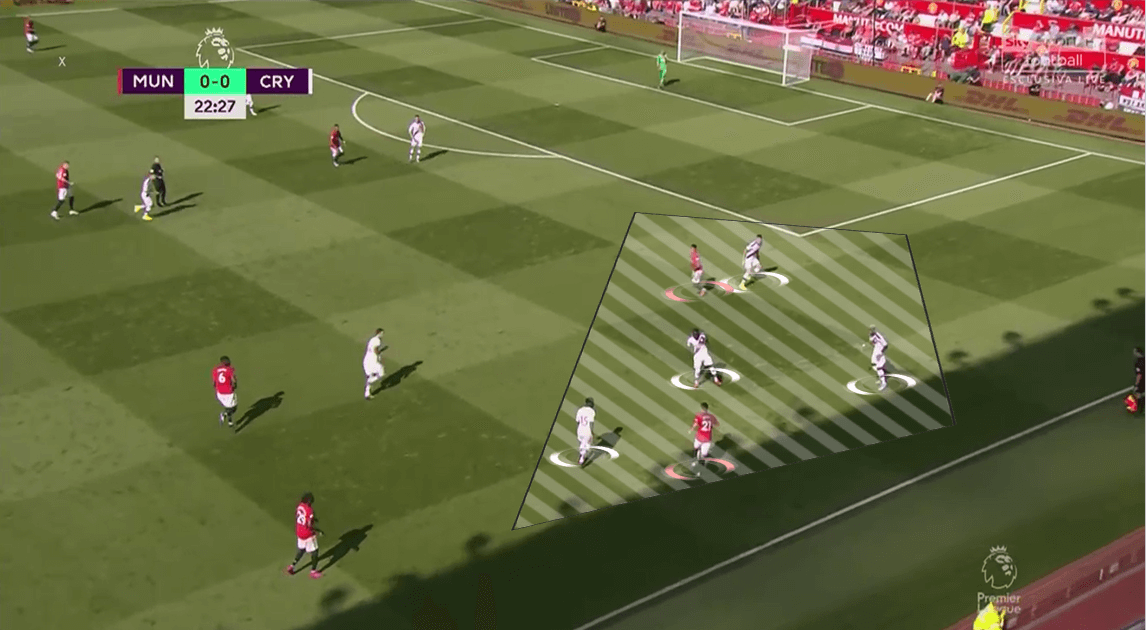
In the shot below, they also created an overload right in front of their box when Pogba attempted to dribble the ball on his own. With four players swarming that area, they were able to block any passing lanes that the French midfielder had. Even when Rashford drove into the box and offered to pick the ball up, Pogba still couldn’t lay the ball to him.
This strategy required the players to have positional and spatial awareness to leave their positions. If they couldn’t time it right to either mark the ball carrier or recover possession, one of the attackers would move in and it left Vicente Guaita’s goal vulnerable.
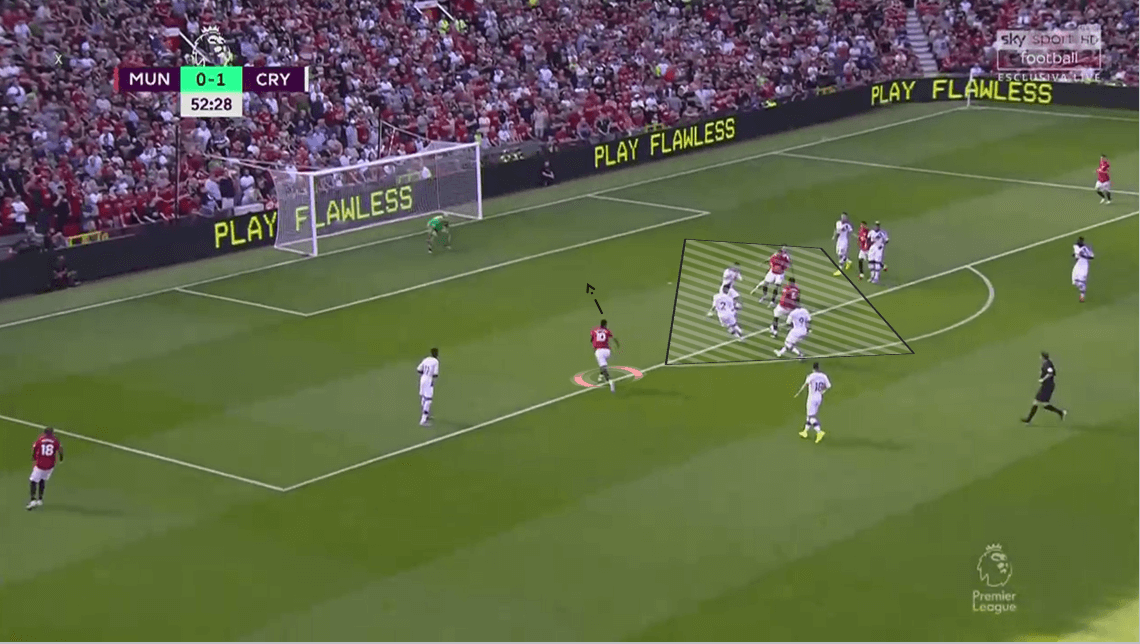
In their attacks, they focused on building from the back while relying on a steady backline and were capable on the ball. The addition of the experienced Gary Cahill helped them a lot in both defence and during their build-up process. The former Chelsea defender made a total of twelve passes and completed nine of them compared to his colleague, Martin Kelly, he made fourteen passes and completed ten.
Not holding much of the possession (29% of ball possession) also hindered more chances for the two centre-backs to involve in playing out from the back. But with Vicente Guaita behind them, they had the option of laying it off to the Spanish goalkeeper and allowed him to make a long ball up the pitch. Ayew’s opening goal was a perfect example of this situation.
Cahill intended to pass the ball back to Guaita, but it was immediately chased down by James. He used his experience to predict the Welsh winger’s run and stepped across him before making the pass. Cahill also shielded the run which created space for Guaita to look for potential receivers and he picked out Jeffrey Schlupp high up the pitch. The Ghanaian nodded towards Ayew which allowed the striker to sprint towards the goal.
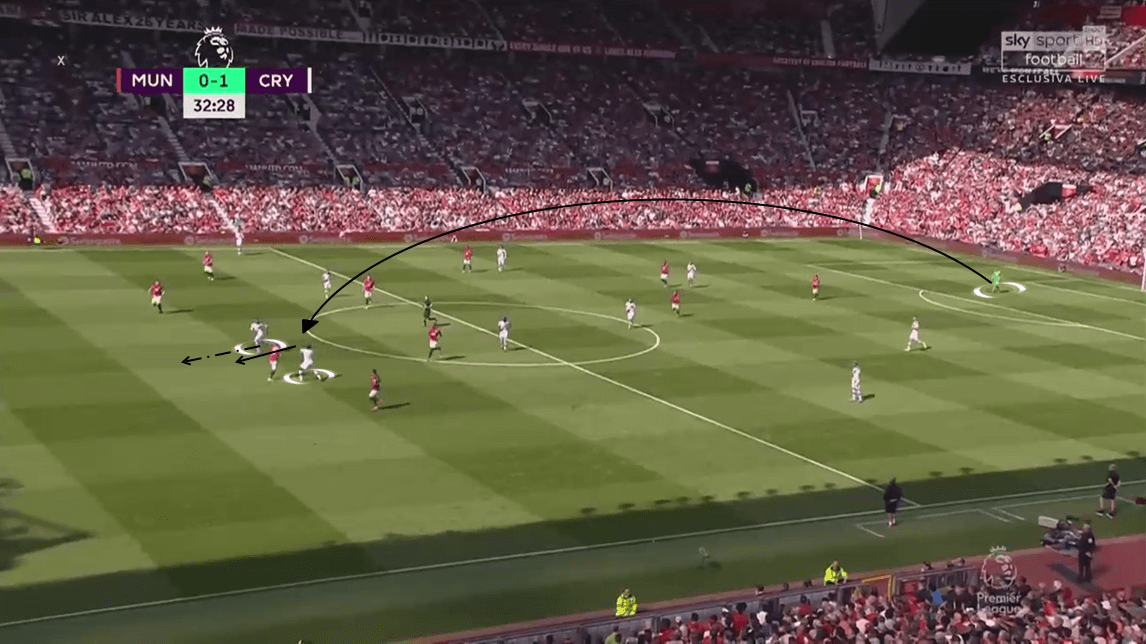
Using direct passes combined with high intensity pressing inside their half also created chances to approach the box. Their winning goal came from a winning duel by Benteke inside their half. Noticing that van Aanholt was overlapped, he made a direct pass towards him and allowed him to continue his run towards the final third.
The Dutch defender laid the ball towards Wilfried Zaha, who was making a run in front of him and attempted to enter the box. His eventual shot was blocked but van Aanholt approached immediately for a follow-up into the bottom left corner.
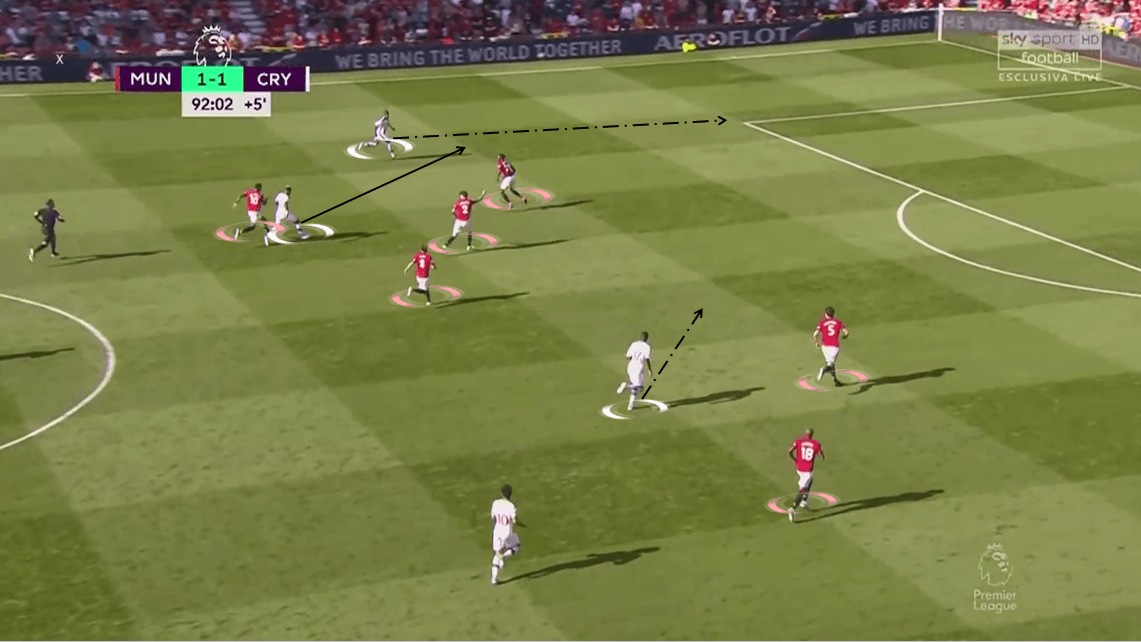
Conclusion
Man United’s first defeat of the season came in a way that no fans would have wanted. Although their style of play was pretty good inside the first half, Ayew’s goal forced them to play with more urgency to find the equalising goal. The second period saw a different approach as the home side tried to create more chances. Eventually, James’ goal tied the match but their defensive vulnerability cost them three points as van Aanholt scored the winning goal.
Crystal Palace’s defensive discipline and their positional awareness allowed them to defend deep in the game. They were able to limit the threat from Man United’s attackers while converting two of their chances at the other end. With their first win, they are hoping to build on this into their challenging season ahead of them.

If you love tactical analysis, then you’ll love the digital magazines from totalfootballanalysis.com – a guaranteed 100+ pages of pure tactical analysis covering topics from the Premier League, Serie A, La Liga, Bundesliga and many, many more. Buy your copy of the August issue for just ₤4.99 here.

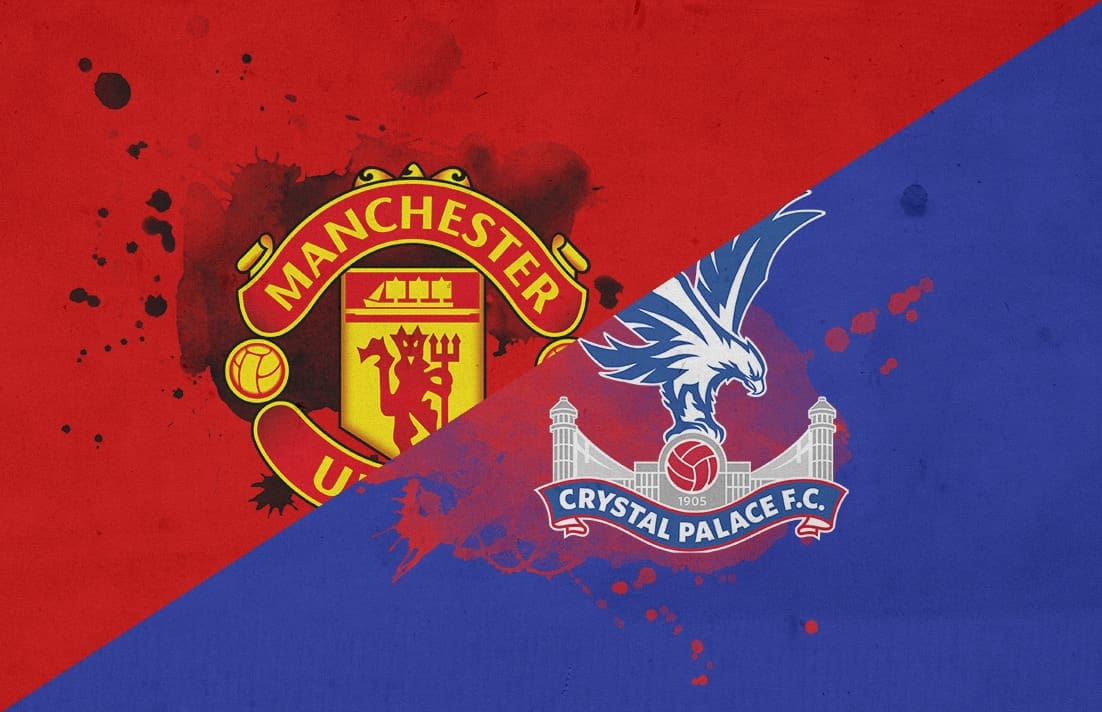



Comments